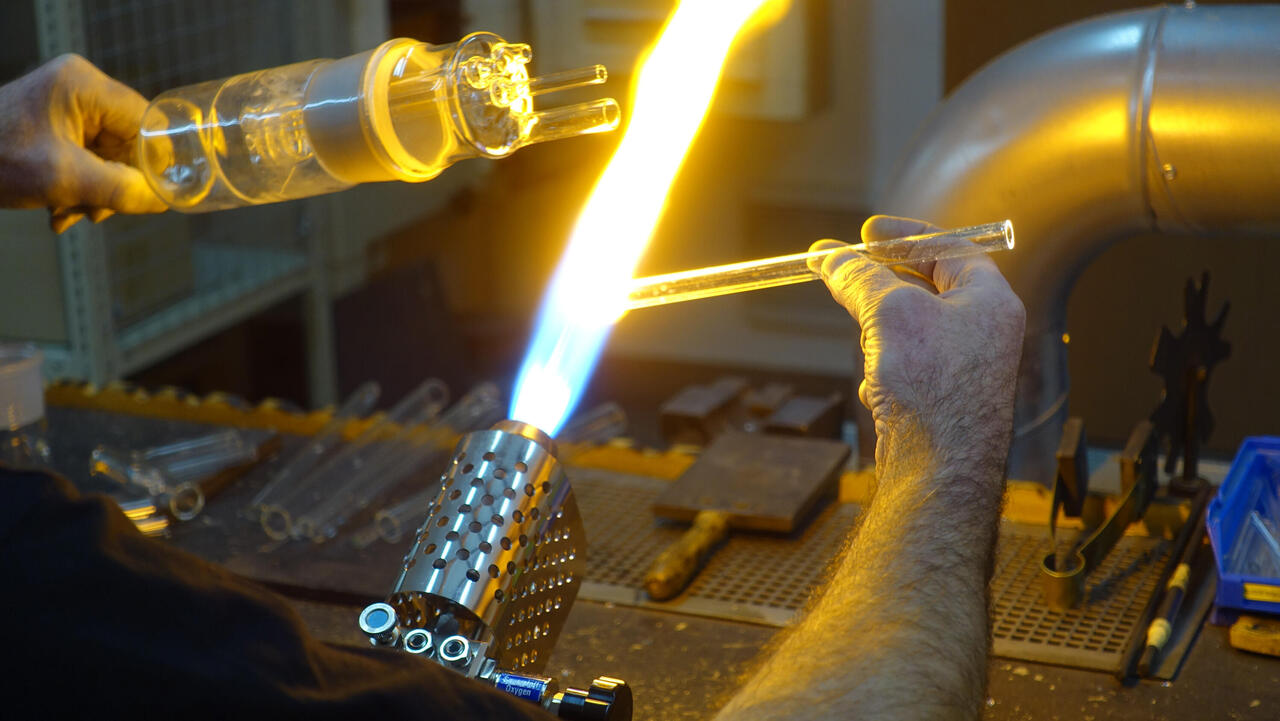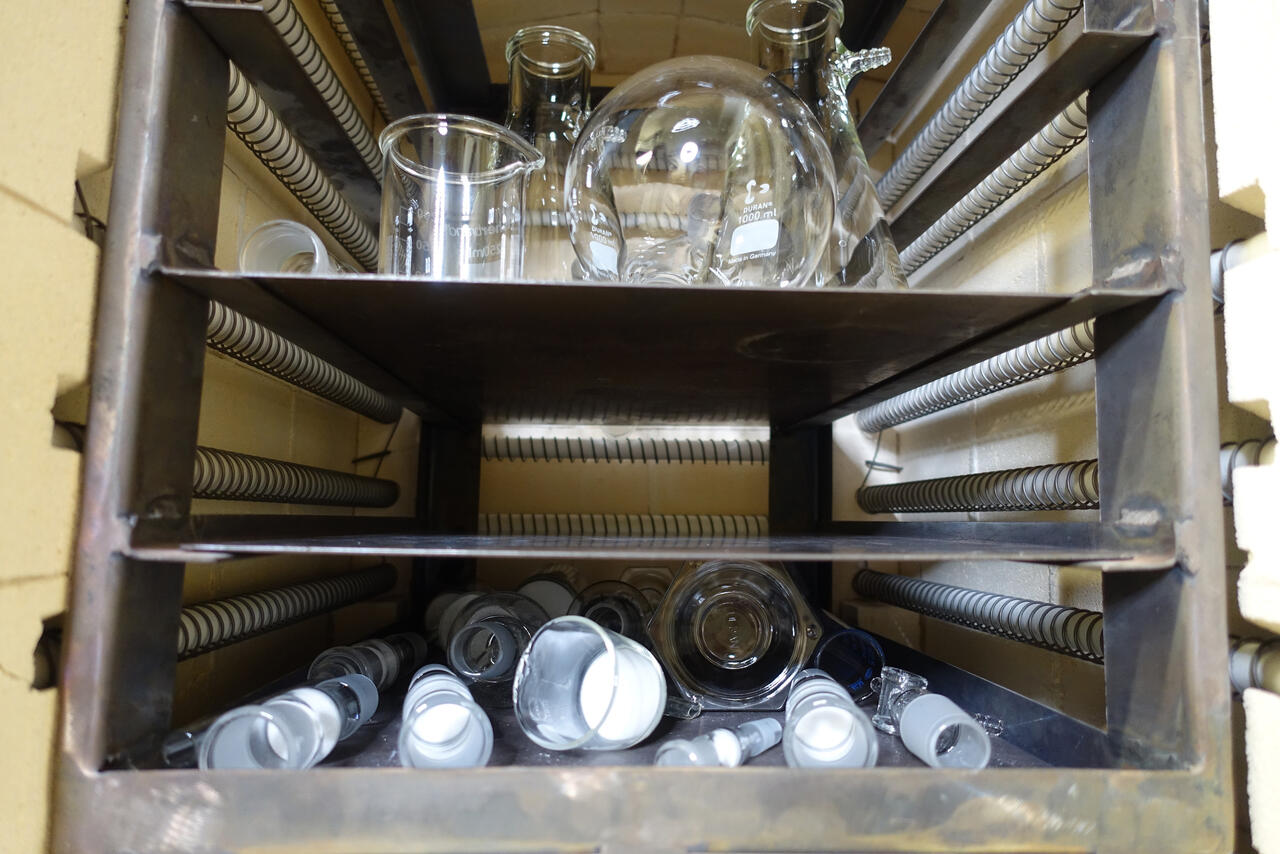Two quiet rooms in the Technical Innovation Centre (TIC), equipped with workbenches, furnace, burners and every kind of tool form the realm of the glass specialist at Topas. At first glance, there may be little evidence of the core competencies of aerosol and particle technology for which the name Topas stands. Nevertheless, the glass apparatus manufacturer and master craftsman for glass technology is an important part of the deep value chain of the Dresden-based company, which has played an important role in the industry for more than 30 years.
Like many trades, the trade of glass apparatus maker struggles with a lack of young talent and few training centres. The profession requires patience, dexterity, and spatial imagination. It is demanding in every respect, and it takes years before one can truly call oneself an expert. These are not necessarily the points that lead young people to choose a profession. And yet: those who choose the profession have good chances to find permanent jobs and exceptional employers. As in our case.
Production parts by hand
In his workshop, the master craftsman works with finished tubes, rods, strips, or flat pieces of various diameters and lengths. All of them are made of glass, of course, a solid made of quartz sand, soda, lime, as well as proportions of dolomite, potash, feldspar, and various oxides, which are fused together at 1600 °C. Topas obtains the add-on parts (standard pieces) made of borosilicate glass from well-known German manufacturers. Laboratory glassware is available in various grades which differ in terms of their properties such as thermal shock resistance of acid resistance.
From these, collection tubes are produced in the glass workshop for the USS 791 Sedimentometer, to name one example. The glass master provides these with firmly defined phases and scales. For the SLG 270 Condensation Aerosol Generator, recipient of the Innovation Prize of the Free State of Saxony, the measuring tubes, the saturator, and the reheater are produced. These workpieces alloy only very small tolerances in the millimetre range and demand high precision and accuracy from the glass apparatus manufacturer. Working with a magnifying glass is indispensable here. For the protection of the craftsman, however, various and—above all, many—measures have to be taken: the familiar safety goggles prevent glaring flame light and its UV load from becoming dangerous to the eyes. Fume hoods reduce the inhalation of toxic gasses or dusts from quartz glass. But also, the right cotton clothing against heat and pollution as well as correct ear protection against the noise of some machines are enormously important.
Suspense guaranteed
The variety of work processes, such as melting, cutting, or polishing requires, in addition to personal protection, above all extensive specialist knowledge and many years of experience. When working with temperatures between 1500 °C (softening temperature) and 2000 °C (processing temperature) for quartz glass, every movement needs to be considered. The master explains to us why the correct glass tension is so important: “if glass is heated and cooled down again too quickly, existing tensions can lead to glass breakage. Glass apparatus must therefore be tempered to low stress in the furnace after processing in the flame.” There, stresses created during processing operations with heat are equalized so that workpieces do not break at stress points. Such points occur, for example, when two pieces of glass are melted together. The furnace’s programmable heat-cold curves are particularly helpful here.
In addition to common cutting tools such as cutting, griding, or turning machines, the glass craftsman works with glass processing tools made of diamonds or reamers and plates made of active carbon. Burners of various designs are also in daily use. For example, in the Topas workshop there are hand burners in normal or mini format based on various gas systems, table burners with a fixed casting base, or burner flutes – steel tubes with a built-in mixing chamber and feet that are used to heat longer glass tubes. Here, the phrase “it’s all in the mix” is true: the right ratio of compressed air, oxygen, and gas is critical, depending on what glass is used and what type of work is to be performed on the workpiece. For example, the glass apparatus manufacturer requires a much smaller flame for heating very delicate workpieces such as the collecting tubes of the USS 791 than for the large-volume tubes of the Thermodenuder.
Passion for the craft
The glass apparatus manufacturer—a long-time employee of Topas—learns from his colleagues in production or research which apparatuses are specifically required. Based on drawings and calculations, he then searches for the appropriate raw material in the glass storage and begins to manufacture his glass workpieces from scratch or to assemble them according to requirements, such as the glass containers with multiple connections for the ATM 220 Atomizer aerosol generator. Whether it’s one-offs or mass production, the highest quality is required for all workpieces. That is why his craftsmanship is in demand beyond Topas in the research and development of universities, institutes, and industry. The master recalls some curious requests with a smile. For example, he has already produced glass props for the Dresden State Operetta or glass candle guards for several Dresden churches. The medium of glass and the associated work with a “solidified liquid” will probably continue to occupy him until retirement. The uniqueness, the multifaceted processing, and the application possibilities of one of the oldest materials of mankind are what has fascinated him for years – a passion that we were undoubtedly able to sense during the conversation.



![[Translate to English:] Glasbläser während der Arbeit, im Vordergrund Glasgeräte und Werkzeuge](https://www.topas-gmbh.de/fileadmin/_processed_/5/0/csm_s-unternehmen-karriere-berufe-glas-4-topas_df45fd6bb1.jpg)